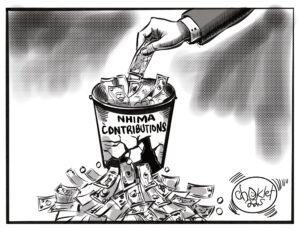BANK of Zambia (BoZ) governor Christopher Mvunga says despite the economic challenges the country is facing, the Central Bank has managed to stabilise the kwacha at an average range of K20.30 per dollar.
Speaking when he officiated at the PriceWaterhouseCoopers (PwC) Zambia bank and non-bank survey launch, Mvunga said the Central Bank had managed to stabilise the kwacha using Monetary Policy instruments.
However, the local currency was trading at around K20.50 per dollar by lunchtime, Wednesday.
With dollar liquidity constrained, the USD/ZMW has been trending upwards in recent days and nearly broke through the K21.00 threshold in Tuesday’s trading session.
“I am sure that by now it’s on the public domain that government does take cognisance of the fact that it’s critical that we resolve the debt issue to create the fiscal space and enhance the ongoing conversation that is taking place between the Ministry of Finance and the various creditors to try and see how we can deal with the debt sustainability issue, including debt restructuring, which would, in-turn, as alluded to that we have foreign currency loans that once you do your debt restructuring and deferment, will create some form of space in order to decelerate the demand for foreign exchange, which hopefully will lead us to a situation where we can stabilise the exchange rate,” Mvunga said in Lusaka, Tuesday.
“I am also glad to say that despite these hard times, we have managed to stabilised it, somehow around the K20.30, K20.40 on the last couple of weeks and I am sure we still be looking at that in terms of what other measures can we put in place to ensure that one of the key macro-economic indicators is actually stable, which is good for business as well. But those are things that we will cover during the analysis of the (Monetary) Policy Committee and a comprehensive feedback will be provided once we have completed that exercise.”
He observed that the K10 billion Medium Term Refinancing Facility was insufficient, hence the need for the banking sector to come on board and support the country’s economic recovery.
“So, from the central bank point of view, we are engaging, yes, there have been some bottlenecks in terms of challenges on the disbursement of this facility. But I met commercial bank CEOs last week, that’s one of the topical areas that we discussed in terms of how we fast-track this process and ensure that we pass on the much-needed benefit to the businesses out here that are hurting because of lack of financing and support in terms of credit extension. I should also hasten to say that given where COVID-19 is in Zambia, I don’t even think that the K10 billion is adequate and we need to think beyond more stimulus for the businesses out there in terms of what we, as the central bank, as the banks themselves, do. It should not be restricted to the central bank. The banks have a role to play because they have got customers and if those customers disappear off your balance sheet, your business is in trouble. So, it’s a collective responsibility between the private sector and the central bank and the government at large to ensure that we embark on a journey where it’s collaborative, supportive because the benefit is for all of us,” he said.
“And I am urging the banks that, in such a situation, we need to preserve the businesses out there to ensure that they don’t die because it’s very difficult to revive them once they have been closed. How do we do that? The commercial banks and the non-bank institutions have a critical role to play and when we talk about innovation, let’s not just talk about innovation of products, let’s talk about innovation of thinking and the processes as well. I have got no doubt in mind that the businesses need support from the financial service providers. We are not seeing as much as we would love to see as a central bank in terms of credit extension to private sector by the commercial banks and my ask is: can you relook at your processes, can you innovate given the circumstances that we are in, given the constraints that we’re faced with to ensure that that credit goes to the private sector so they can actually resume their business activities? The more we starve them of the credit, the more the industry is vulnerable and the more the economic activity will reverse.”
And Mvunga announced that K500 million from the K10 billion facility was expected to be disbursed this week, bringing the total to around K3 billion.
“Of that, I can actually give you an update that we are pushing hard as a central bank in conjunction with the commercial banks and the non-banking financial service providers, who qualify to administer this facility on our behalf. The latest position as we stand is that the total approved is K6.4 billion. So, approved, it’s approved by the central bank for the financial services providers to onward lend to their customers. There is a process before that, which the financial services providers themselves need to look at their customers internally and do an assessment whether they should proceed or not. For the amounts disbursed, so far we have disbursed K2.45 billion. I am very confident that there will be an additional disbursement of K500 million within the course of this week, which will bring the disbursements to K3 billion,” said Mvunga
And Bankers’ Association of Zambia (BAZ) chairperson Herman Kasekende said that investments in social sectors could only be done when the country’s debt reached sustainable levels.
“There are conversations with the IMF, conversations with G-20 and, of course, there are conversations with lenders from China and all these I think are meant to ensure that the country gets to a debt sustainability level of affordability and that will bring a lot more confidence into the economy, but also will create space for investments into the social sectors. We have got a higher percentage of Zambians under the age of 16, they need to be educated. We have got the challenges of COVID-19, we need a lot more interventions or investments into the health and there are others in areas of infrastructure, but that cannot happen until the fiscal space is actually created and key on that is to ensure that the debt service gets to a level where it’s affordable and it’s sustainable and that is I think the key intervention or the key actions around that,” said Kasekende, who is also Standard Chartered Bank Zambia Limited chief executive officer.
Meanwhile, PwC country senior partner Andrew Chibuye said that Non-Performing Loans (NPLs) had increased to 12.6 per cent from around 8 per cent last year
“For commercial banks, we had started to turn a corner between 2018/2019 with the Non-Performing Loan ratio reducing from 9.5 per cent to just above 8 per cent. If you extrapolate that to June, 2020, that is now at 12.6 per cent. So, we have started to see a fairly significant reversal in the gains that have been made,” said Chibuye in a presentation of the findings.
“We then analysed the trends on the loans disbursed on a quarter-by-quarter basis going back to the first quarter of 2019. And you see that the first quarter of 2019, K14.7 billion was disbursed; quarter two was K5.8 billion. We are currently at the end of quarter two of 2020 and we are at K4.781 billion so, it’s trending downwards. Obviously, there is a lot more selectivity around credit risk in this particular environment, but it’s hoped that that will start to turn around as the country continues to open up and more business activity begins to take place. If you look at the absolute number of loans issued, you can see that between quarter two of 2019, where two million loans were issued; quarter two of 2020, 745,000, so that’s a fairly dramatic turnaround reduction.”
























